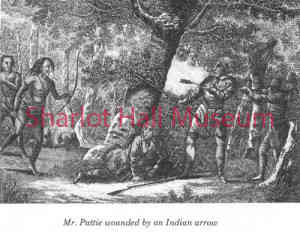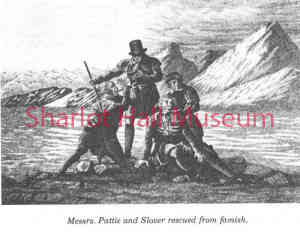By Bob Harner
If you have been following our series on “How Arizona Got on the Map,” you’ll recall that by 1821, the land that would come to be known as Arizona was part of Mexico. There were Spanish-speaking settlements at Tubac and Tucson. North of Tucson the land was largely ungoverned. There were no English-speaking settlements; there was no Anglo presence. Into this void stepped a handful of rugged individualists who cared little for governments or boundaries. These were the “Mountain Men” – men like James Ohio Pattie.
Before Arizona was called Arizona and before New Mexico became a U.S. territory, the areas along the Gila, Salt, Colorado and Little Colorado Rivers were being explored and exploited by enterprising and adventurous American and French fur trappers. For a brief time, one of the best known of these trappers was a young man named James Ohio Pattie, possibly one of the first Americans to see the Grand Canyon.
 Pattie achieved his moment of fame not because of what he may have actually done, but because of what he said he did in a published memoir (1831, reprinted 1833), The Personal Narrative of James O. Pattie, co-written with Timothy Flint, a popular writer of both fiction and non-fiction at the time. Most scholars are skeptical about the accuracy of some of Pattie’s account, believing that he adapted several stories he heard about other trappers into his own life. On the other hand, independent historical records confirm a number of Pattie’s adventures, including some of the more unlikely ones. The two articles in this series will largely take Pattie at his word.
Pattie achieved his moment of fame not because of what he may have actually done, but because of what he said he did in a published memoir (1831, reprinted 1833), The Personal Narrative of James O. Pattie, co-written with Timothy Flint, a popular writer of both fiction and non-fiction at the time. Most scholars are skeptical about the accuracy of some of Pattie’s account, believing that he adapted several stories he heard about other trappers into his own life. On the other hand, independent historical records confirm a number of Pattie’s adventures, including some of the more unlikely ones. The two articles in this series will largely take Pattie at his word.
In 1824, depressed by the death of his wife, Sylvester Pattie, a former army lieutenant in the War of 1812, decided to leave his Missouri home and take up trapping. His 20-year-old son, James, joined him. Together with three others, they outfitted an expedition to trap and trade with natives in what would become Iowa. Blocked by authorities for lacking a permit, they changed direction for New Mexico (still under Mexican rule) to join a larger expedition led by Sylvester Pratte. In August of 1825, they trapped a beaver, the first that James had ever seen.
The group continued to Taos, where James ate his first tortillas, and then to Santa Fe where they asked the Mexican governor, Antonio Narbona, for permission to trap along the Gila River, offering a 5% kickback as an incentive. The governor was reluctant. At that point, fate intervened when local native people kidnapped several women, including the daughter of a former governor, Francisco Javier Chavez. Working with Mexican soldiers, the Patties staged an ambush and James personally rescued Chavez’s daughter, Jacova, whom he describes as “a beautiful young lady.” The grateful governor granted them a license, and they began trapping along the Gila River in New Mexico Territory, including the area that would become Arizona.
Although their trapping efforts were successful (ultimately acquiring more than 250 pelts), their journey was both difficult and dangerous, with multiple attacks by both mountain lions and bears. Their encounters with natives varied, sometimes involving peaceful trading but often resulting in the type of violent and brutal behavior on both sides that was typical for the time and place.
 After burying their initial 250 pelts near the Gila (to be retrieved later), they reached the location of the present-day Coolidge Dam. After an exhausting mountain detour, they arrived at the San Pedro River, where they trapped an additional 200 beaver. Scholars believe they likely reached the Sacaton Mountains near today’s Casa Grande before turning back. At this point, it’s unclear how many trappers remained, as a number had died of various causes and others had given up and returned to New Mexico earlier.
After burying their initial 250 pelts near the Gila (to be retrieved later), they reached the location of the present-day Coolidge Dam. After an exhausting mountain detour, they arrived at the San Pedro River, where they trapped an additional 200 beaver. Scholars believe they likely reached the Sacaton Mountains near today’s Casa Grande before turning back. At this point, it’s unclear how many trappers remained, as a number had died of various causes and others had given up and returned to New Mexico earlier.
The Patties arrived at the Santa Rita del Cobre copper mines (near today’s Silver City, New Mexico), where they again buried their pelts. Leaving his exhausted father at the mines, James traveled to Santa Fe to acquire supplies and additional horses to transport the pelts. He returned to find the main stash stolen, leaving only a handful of additional pelts he had buried elsewhere.
With little to show for their travails, the Patties hired on as guards at the mines, where James learned Spanish from the superintendent, Don Juan Onis. In time, Onis offered to rent the mine to Sylvester on terms very profitable to the elder Pattie. Sylvester accepted, but James was restless, writing: “I had a desire, which I can hardly describe, to see more of this strange and new country.”
James joined a group of French trappers led by Michel Robidoux and they set off, eventually teaming with another group led by Ewing Young. After some successful trapping (and considerable hardship), the group split into two to return to Santa Fe, with Pattie’s group traveling along the North Rim of the Grand Canyon.
In Santa Fe, Pattie had another setback when the governor confiscated all their pelts, claiming that a new policy nullified their permit. Discouraged and penniless, Pattie rejoined his father at the mines.
“Days Past” is a collaborative project of the Sharlot Hall Museum and the Prescott Corral of Westerners International (www.prescottcorral.org). This and other Days Past articles are also available at https://sharlothallmuseum.org/articles/days-past-articles.l. The public is encouraged to submit proposed articles and inquiries to dayspast@sharlothallmuseum.org. Please contact SHM Library & Archives reference desk at 928-445-3122 Ext. 2, or via email at archivesrequest@sharlothallmuseum.org for information or assistance with photo requests.


